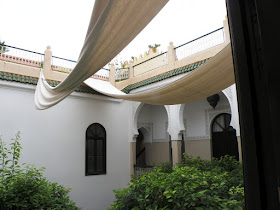
 |
| Shade canopies over courtyard |
 |
| Bill at front door to our riad |
 |
| Bill coming out of our riad onto street |
 |
| Door to a newer riad |
 |
| Door to a newer riad |
 |
| Courtyard of Riad Ajurzame |
We were greeted by a nice quiet young man named Saeed and he invited us to sit in the courtyard and enjoy a welcoming beverage and snacks while he placed the luggage in our room upstairs. The courtyard was lovely. There were a couple of large orange trees and lots of plants, along with seating and lounging areas filled with low cushions. As I wrote already, the courtyard had no roof and was open to the sky, but did have several large cloth canopy strips which provided welcome shade. A very welcoming space.
 |
| Small section of rooftop terrace of our riad |
Later I walked up to the terrace on the rooftop. Several nice places to relax up there.
 |
| Looking onto courtyard from window of our room |
 |
| Bill looking out window of our room into courtyard |
 |
| Area at one end of courtyard of the riad |
 |
| Lounging area and office at opposite end of courtyard |
As Bill sipped his beer and I gulped a much needed bottle of water, soon we were joined by Aziz, who I believe is the manager of the riad, a very charming young man. Aziz talked with us,showed us maps of the city, and provided ideas of things to see and places to eat. Much appreciated by us because we did not have a tourist guide book for Marrakesh. He also advised us about what to be careful about in the crowded areas; he was a fountain of information provided with a constant smile. We agreed on a time of 8pm for dinner. Then we went up to our room to freshen up before setting out to explore Marrakesh by foot.
 |
| Part of our room at Riad Ajurzame |
 |
| A colorful wall of carpets for sale. |
The busiest square in all of Africa is located in Marrakesh: the Jemaa el-Fnaa. And that is where we headed first. The origin of the name of this square is unclear. Jemaa means "congregation" in Arabic, which probably refers to a destroyed very old mosque. Fana or fina can mean "death" or "a courtyard or space in front of a building." So, the meaning could be "the congregation of death." Another explanation is that Jemaa el-Fnaa translates to "assembly of the dead" which could refer to the public executions on this plaza around 1050 A.D. Today this plaza is filled with vendors and food stalls, along with trained monkeys and snake charmers and various entertainers. And pickpockets. Lots and lots of highly skilled pickpockets.
Here is a photo of the Jemaa el-Fnaa which comes from the Wikipedia website. This looks like an older photo because to me the area looks different today.
 |
| Lots of trained monkeys around the plaza. Pay for photo. |
 |
| Masks must be a popular sales item. These were everywhere. |
 |
| Small group of African musicians and dancers |
 |
| This guy REALLY wanted me to take his photo. 10 dirham, please. |
Everyone here expects to be paid if someone takes their photo. And never take a photo without asking permission first. If they say okay, then agree on a price or you might find yourself with an angry man insisting on more than you wish to pay. Helpful advice that Aziz had provided to us before we ventured out to explore.
 |
| A tajine. The typical method of cooking those delicious Moroccan dishes. |
 |
| A dinner plate at the riad. I liked this pattern and would love to buy a set of these porcelain dishes. These are manufactured in Fes. I shopped for these in Marrakesh but could not find this pattern. |
The meal was accompanied by a delightful red wine made near Fes. Okay, that was a surprise. Had no idea that any wine was produced in Morocco. And it really was good. Aziz said we were allowed 2 bottles of wine with dinner. Seriously? We cannot drink 2 bottles of wine...ever...no matter how good it tastes. We told him to keep the second bottle for someone else. Desert was a slice of 3 layered ice creams made there in the riad. Decadence. We enjoyed this meal very much and now I must buy a tajine!
 |
| Judy and Aziz in front of Riad Agurzame |
I did not take a cooking class in Marrakesh (although this was HIGHLY recommended), but I think I can learn Moroccan cooking on my own. But first must buy a tajine.


Marrakesh, Morrocco ... would love to visit there someday! Still enjoying your blog!
ReplyDelete